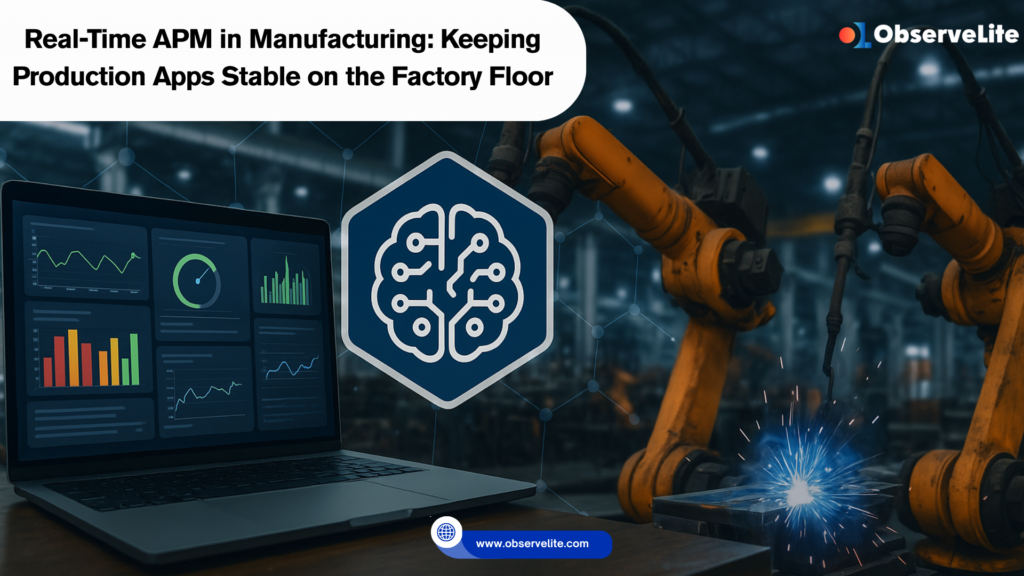Modern factories run on complex applications that power everything from scheduling and supply chain logistics to robotics and quality control. When these applications slow down or fail, production stops, costs rise, and customer commitments are at risk. This is why real-time APM in manufacturing has become essential.
By monitoring applications continuously, manufacturers can detect issues early, prevent downtime, and optimize workflows. Unlike traditional IT monitoring, manufacturing application performance monitoring brings together OT (operational technology) and IT, ensuring the factory floor operates with stability and efficiency.
What Is Real-Time Application Performance Monitoring in Manufacturing?
Real-time APM in manufacturing is the continuous monitoring of applications, APIs, databases, and machine-level software in production environments. It ensures:
- Constant visibility into application health.
- Rapid detection of errors or slowdowns before they disrupt operations.
- Automated corrective actions to minimize downtime.
This approach bridges IT and OT, offering the foundation needed for digital-first factories.
How Does APM Improve Manufacturing Efficiency?
Efficiency is critical in industries where every second counts. APM improves efficiency by:
- Tracking machine-to-machine communication and ensuring real-time synchronization.
- Monitoring production scheduling systems to prevent bottlenecks.
- Ensuring ERP and MES applications run without lag.
For manufacturers adopting Industry 4.0, APM ensures connected devices, apps, and workflows operate seamlessly.
What Are the Benefits of Real-Time Production Monitoring?
Real-time production monitoring powered by APM offers several advantages:
- Reduced downtime: Detect and resolve issues before they halt production.
- Predictive analytics: Identify early signs of equipment strain.
- Quality assurance: Ensure production apps maintain accuracy for defect-free output.
- Cost savings: Optimize resource usage by minimizing unplanned outages.
How Can APM Reduce Machine Downtime in Factories?
Downtime continues to be a key factor driving up operational costs in manufacturing. Predictive maintenance with APM helps reduce downtime by:
- Tracking anomaly patterns in machine-control apps.
- Alerting teams when machines show early warning signs of failure.
- Suggesting proactive fixes such as load balancing or workflow rerouting.
This reduces costly emergency repairs and keeps production continuous.
What KPIs Should Be Tracked in Manufacturing APM Systems?
Some key performance indicators (KPIs) to track include:
- Mean Time to Detect (MTTD): How quickly anomalies are identified.
- Mean Time to Repair (MTTR): How fast issues are resolved.
- Application response times: Critical for MES and SCADA systems.
- Downtime frequency and duration: To measure production stability.
- Throughput and error rates: Ensuring apps don’t create bottlenecks.
How Is APM Different from Predictive Maintenance in Manufacturing?
While often confused, they serve different purposes:
- Predictive maintenance: Focuses on physical equipment health using IoT and sensors.
- Real-time APM in manufacturing: Focuses on applications and digital workflows that support machines and production processes.
Together, they create a holistic view of both physical and digital operations.
Can APM Integrate with MES and SCADA Systems?
Yes. Manufacturing application performance monitoring integrates with MES (Manufacturing Execution Systems) and SCADA (Supervisory Control and Data Acquisition) systems to:
- Monitor application-layer performance for machine controllers.
- Track the interaction between real-time production data and enterprise applications.
- Deliver unified dashboards that give operations leaders end-to-end visibility.
What Challenges Arise When Implementing APM in Legacy Systems?
Legacy systems often lack compatibility with modern APIs or data streams. Challenges include:
- Limited observability from older software.
- High integration costs.
- Resistance to change from staff accustomed to traditional monitoring.
Modern APM platforms overcome this with lightweight agents, API adapters, and AI-driven insights that translate legacy signals into actionable intelligence.
How Does AI Enhance Real-Time APM in Industrial Settings?
AI adds predictive and adaptive power to real-time APM:
- Anomaly detection: Identifies subtle deviations before they escalate.
- Predictive modeling: Forecasts demand spikes and system load.
- Self-healing automation: Applies fixes automatically (e.g., rerouting traffic).
This ensures APM evolves with the environment rather than remaining static.
What’s the ROI of Deploying APM in Manufacturing Plants?
The ROI of real-time APM in manufacturing comes from:
- Reduced downtime and fewer unplanned stoppages.
- Improved worker productivity through faster issue resolution.
- Lower maintenance costs via predictive insights.
- Higher throughput and better quality control.
Many manufacturers report a positive ROI within the first year of deployment.
How Does Real-Time APM Support Industry 4.0 Initiatives?
Industry 4.0 requires interoperability between IoT devices, cloud-based platforms, and production software. Real-time APM supports this by:
- Monitoring APIs between IoT devices and cloud apps.
- Ensuring robotics and automated systems perform consistently.
- Offering centralized dashboards for real-time decision-making.
Without APM, the vision of smart factories remains vulnerable to disruption.
Are There Open-Source APM Tools for Manufacturing Environments?
Yes, open-source tools exist, but they often lack:
- Predictive AI models.
- Compliance-focused dashboards.
- Self-healing automation.
For mission-critical manufacturing operations, enterprise-grade solutions like ObserveLite APM offer the reliability, compliance, and AI-driven insights manufacturers need.
Conclusion
As factories evolve into digital-first ecosystems, the stability of production apps becomes just as important as the physical machinery they power. Real-time APM in manufacturing is the key to ensuring uninterrupted workflows, optimized resources, and resilient Industry 4.0 operations.
Platforms like ObserveLite APM bring manufacturers the ability to monitor applications continuously, predict issues, and automate responses. For organizations looking to scale, this is not just a technology upgrade — it’s a competitive necessity for the future of manufacturing.


